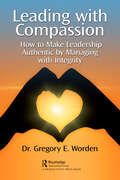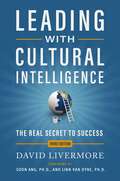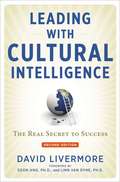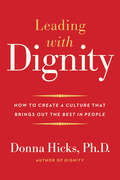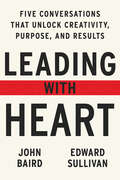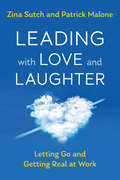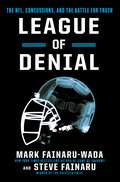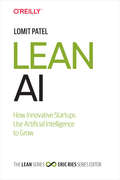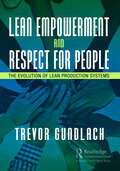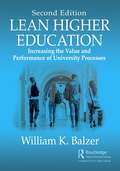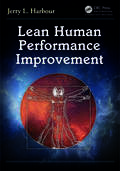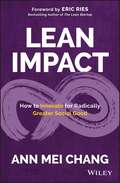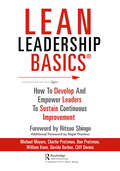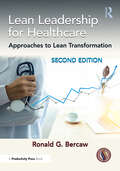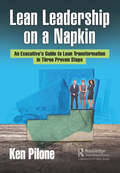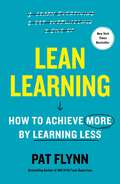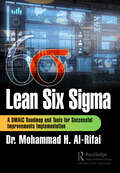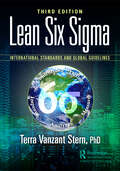- Table View
- List View
Leading to Occupational Health and Safety: How Leadership Behaviours Impact Organizational Safety and Well-Being
by E. Kevin Kelloway Jennifer K. Dimoff Karina NielsenLeading to Occupational Health and Safety brings together prominent researchers to explore the pervasive roles that leaders play in determining the health, safety and mental well-being of employees in organizations. The first text to directly link organizational leadership behaviours with health and safety outcomes, covering theory, research and evidence-based best practice Argues that a leader’s impact can be far more far-reaching than is commonly realized, and examines the effects of leadership on safety, physical wellness and wellbeing, and psychological wellbeing Explores the theoretical underpinnings of effective leadership styles and behaviors, and advances both research and practice in order to encourage better leadership and healthier, safer organizations Features contributions from internationally known and respected researchers including Sharon Clarke, Kara Arnold, Fred Luthans, Ståle Einarsen, Julian Barling, and Emma Donaldson-Feilder
Leading with Compassion: How to Make Leadership Authentic by Managing with Integrity
by Gregory E. WordenBusiness schools teach the transactional tools one needs to work in business. They teach various strategic planning and decision-making models such as SPACE or SWOT or decision trees or weighted grids. They teach about the various functions of an organization, financial ratios, and breakeven analyses. And they may even have a class on business ethics. But those tools are more about knowing where the business-case boundaries are as a risk prevention measure and do not help one to think about how they should comport themselves as a leader. This book is about helping you to become your best self and helping those around you to achieve their best. Inherently it’s about authenticity, integrity, and empathy and how these simple traits can lead to high performance. The book explores ways to make our leadership more authentic and to lead with integrity. It discusses how to mentor employees and how this can lead to higher-performing teams and more successful organizations. The book is organized around four major constructs. The first is about personal leadership. It starts with honesty and integrity. That provides the basis for an empathetic leadership style. This is one that helps to engage followers and brings them along because they want to come along for the journey, rather than feeling forced. That is the nature of the second construct: building and maintaining high-performing teams. This is then the basis for building a trusting culture. Change is all around us and that can be exhausting. Building a culture of trust is the first step toward building an agile organizational culture. That is the third construct. Finally, the last is a message of simple optimism. There are many challenges facing society today, but with thoughtful, engaging leaders there is hope that we can collectively rise to the challenge.
Leading with Cultural Intelligence 3rd Edition: The Real Secret to Success
by David LivermoreAs our workplaces become increasingly global and diverse, being a culturally intelligent leader isn't just a bonus—it's essential.Whether you're negotiating a contract with a supplier on the other side of the world, managing an increasingly diverse workforce, expanding your business across borders, or developing and applying cultural intelligence (CQ), this classic resource provides you with the adaptability you need to motivate, negotiate, and accomplish results with anyone, anywhere.Having done consulting and research with leaders in more than 100 countries, David Livermore, founder of the Cultural Intelligence Center and professor at Boston University, has detailed the four CQ skills that are proven to maximize your leadership success in today&’s diverse, global business environment:Drive—build your motivation and confidence to address cultural dilemmasKnowledge—learn how to read any cultural situationStrategy—create an inclusive, agile plan that accounts for diverse stakeholdersAction—adapt your leadership style without compromising effectiveness Featuring the latest research, case studies, and new chapters on how to lead culturally intelligent organizations and teams, this new edition of Leading with Cultural Intelligence will help you thrive in any leadership environment—whether it's across the world or in your own back yard.
Leading with Cultural Intelligence: The Real Secret to Success
by David LivermoreBusiness today is global--and success requires a new set of skills. But not to worry, whether you're negotiating with vendors in Asia, exploring potential markets in Africa, or leading a diverse team at home, you don't have to master the nuances of every culture you encounter. With Cultural Intelligence, or CQ, you can lead effectively in any context. Featuring fresh research, case studies, and statistics on the ROI of improving your CQ, this new edition of Leading with Cultural Intelligence details a powerful, four-step model for becoming more adept at managing across cultures: Drive--boost your motivation for and confidence in interacting with other cultures Knowledge--understand the relevance of differences in religion, values, norms, and languages Strategy--plan ahead for unfamiliar cultural settings, but remain flexible if actual experience differs from expectations Action--successfully adapt your behavior to each situation With Leading with Cultural Intelligence as your guide, you'll be able to thrive in any business environment--whether it's across the world or in your own backyard.
Leading with Dignity: How to Create a Culture That Brings Out the Best in People
by Donna HicksWhat every leader needs to know about dignity and how to create a culture in which everyone thrives This landmark book from an expert in dignity studies explores the essential but under-recognized role of dignity as part of good leadership. Extending the reach of her award-winning book Dignity: Its Essential Role in Resolving Conflict, Donna Hicks now contributes a specific, practical guide to achieving a culture of dignity. Most people know very little about dignity, the author has found, and when leaders fail to respect the dignity of others, conflict and distrust ensue. She highlights three components of leading with dignity: what one must know in order to honor dignity and avoid violating it; what one must do to lead with dignity; and how one can create a culture of dignity in any organization, whether corporate, religious, governmental, healthcare, or beyond. Brimming with key research findings, real-life case studies, and workable recommendations, this book fills an important gap in our understanding of how best to be together in a conflict-ridden world.
Leading with Feminist Care Ethics in Higher Education: Experiences, Practices, and Possibilities
by Christie SchultzThis book explores how academic leaders throughout higher education experience and practice care and the ethics of care. Drawing on a narrative inquiry study of experiences and practices of feminist care ethics in higher education leadership, Schultz counters academic norms, including expectations of competition and criticism across all activities, by uncovering the common experiences of academic leaders who intentionally adopt practices guided by an ethics of care and relationality. Within the context of institutions of higher education responding to present-day social movements, the book highlights how practices of care-centered leadership can enable change that begins on campus and reaches outwards to positively impact the community.
Leading with Heart: 5 Conversations That Unlock Creativity, Purpose, and Results
by John Baird Edward SullivanTwo veteran executive coaches help today's leaders learn how to retain and inspire their teams through the one thing their research has found works: Leading with Heart. In these pages, leadership coaches John Baird and Edward Sullivan share hundreds of hours of research and firsthand accounts of guiding leaders at some of the world's most respected big brands and small startups (Apple, Nike, Google, and Slack to name a few). Through their coaching and research they uncovered the five behaviors transformative leaders engage in to connect authentically with their teams: They are aware of their people's needs. They help their people to confront the fears that hold them back.They understand their own desires and what drives their people. They leverage their unique gifts and help people find their own. They connect with their core sense of purpose and help people find theirs. The key to achieving these behaviors is asking the right questions and having conversations that connect you and your employees on the deepest human level—conversations the authors coach you on how to navigate.At a time when workplaces are struggling to build high morale and connected cultures, Leading with Heart will help leaders to unlock the best version of themselves and those around them with transformative results.No matter where you are in your career, this book is your launch point to leading with heart. By encouraging you to ignore outdated “leadership hacks” and embrace introspection and growth, Leading with Heart guides you to ask the right questions and find your own answers. Now you too can create a leadership game-plan that is authentic to you and brings out the best in those around you.
Leading with Humility
by Rob Nielsen Jennifer A. Marrone Holly S. FerraroThe media is saturated with images of leaders as powerful, headstrong individuals, who are certain of their position and willing to do whatever it takes to achieve their organizational goals or personal ambitions. In reality, far too often, a leader’s ego gets in the way of sound decision making, adversely affecting the organization and the individuals involved. This insightful book, based on cutting edge research, advances a new model for understanding effective leadership. Nielsen, Marrone and Ferraro advocate the idea of leading with humility, a trait that is rarely discussed and frequently misunderstood. Humble leaders consider their own strengths, weaknesses and motives in making decisions, demonstrating concern for the common good, and exercising their influence for the benefit of all. Leading with Humility offers students and leaders clarity in understanding the connection between leadership and humility, and teaches them how to enhance their own abilities to become better leaders.
Leading with Love and Laughter: Letting Go and Getting Real at Work
by Patrick Malone Zina SutchLeadership has for too long been treated as a function and not as a relationship. Zina Sutch and Patrick Malone argue that successful leadership must be based on love (altruism and empathy) and laughter (positive emotions and joy).Science tells us that humans are deeply wired for empathy and compassion and that our emotional selves help us make better decisions and motivate others. However, the tactics we use to train leaders bear little reflection of these advancements; we're still creating competent but emotionally distant leaders who "manage human assets" and lead by setting goals, deadlines, and deliverables.Zina Sutch and Patrick Malone hope to flip a light switch and illuminate, above all else, that leadership begins with heart and soul. Too many training programs reduce leadership to an equation, matrix, or acronym. But leadership is a relationship. It's one human helping another. The most successful leaders show they genuinely care about their employees and are, well, fun. It's just like any relationship. In seven succinct chapters, the authors show that people lead best when they tap into their genetically driven human nature to love and nurture, connect and trust. Leading with love and laughter offers powerful dividends: tighter teams, stronger performance, improved morale, greater trust, more creativity, and even better health. While Sutch and Malone cite the science and offer examples, tips, and practices, their larger purpose is to reintroduce the warmth of human interaction and emotion as the foundation of what leadership is all about.
Leading with Love: Rehumanising the Workplace
by Karen Blakeley Chris BlakeleyAs business becomes more automated, power more concentrated, and the forces of competition and consumption seem to dominate our lives, we are in danger of losing what it is to be human. Work for many can be a soulless activity, creating feelings of disempowerment, alienation, and depression. Learning to lead with love is a counterforce to the instrumentalisation of the person. This book presents original research based on leaders who were nominated by their people for leading with love. It shows how they learned to lead with love for the benefit of themselves, their organisations, and their people. It shows that leading with love is something that is practised by leaders who are more emotionally, morally, and spiritually mature. Leading with love is a sign of psychological maturity, whilst leading with fear is a sign of hindered emotional and spiritual development. Based on this research, this book presents a simple framework to help leaders who wish to develop their psychological maturity and apply practices which will enable them to successfully lead with love.
Leading with Vision: The Leader's Blueprint For Creating A Compelling Vision And Engaging The Workforce
by John Maketa Bonnie Hagemann Simon VetterWhat does it mean to lead with vision? In the first book devoted entirely to vision as a key leadership principle, the authors delve deeply into the notion that a compelling vision that motivates and inspires is a true differentiator for organizations that want to hire and retain talent, be more competitive, and thrive in uncertain times. But a compelling vision on its own is not enough, which is why the authors, sought-after leadership development experts globally, provide readers with detailed analysis of the essential things leaders must do to effectively engage the workforce around that vision: embody courage, forge clarity, build connectedness, and shape culture.Leading with Vision draws on quantitative data from the authors' research of over 400 companies supplemented with real-world examples from thoughtful leaders who exemplify the core principles of leading with vision in established companies, including: Olukai, Bumble Bee, Coresystems, Jimbo's, Bunge, and more. The book also includes an actionable blueprint developed by the authors that leaders and their organizations can implement on day one of their journey.
League of Denial: The NFL, Concussions, and the Battle for Truth
by Mark Fainaru-Wada Steve Fainaru"PROFESSIONAL FOOTBALL PLAYERS DO NOT SUSTAIN FREQUENT REPETITIVE BLOWS TO THE BRAIN ON A REGULAR BASIS." <P><P>So concluded the National Football League in a December 2005 scientific paper on concussions in America's most popular sport. That judgment, implausible even to a casual fan, also contradicted the opinion of a growing cadre of neuroscientists who worked in vain to convince the NFL that it was facing a deadly new scourge: A chronic brain disease that was driving an alarming number of players -- including some of the all-time greats -- to madness. <P><P>League of Denial reveals how the NFL, over a period of nearly two decades, sought to cover up and deny mounting evidence of the connection between football and brain damage. <P><P>Comprehensively, and for the first time, award-winning ESPN investigative reporters Mark Fainaru-Wada and Steve Fainaru tell the story of a public health crisis that emerged from the playing fields of our 21st century pastime. Everyone knew that football is violent and dangerous. But what the players who built the NFL into a $10 billion industry didn't know - and what the league sought to shield from them - is that no amount of padding could protect the human brain from the force generated by modern football; that the very essence of the game could be exposing these players to brain damage. <P><P>In a fast-paced narrative that moves between the NFL trenches, America's research labs and the boardrooms where the NFL went to war against science, League of Denial examines how the league used its power and resources to attack independent scientists and elevate its own flawed research -- a campaign with echoes of Big Tobacco's fight to deny the connection between smoking and lung cancer. <P><P>It chronicles the tragic fates of players like Hall of Fame Pittsburgh Steelers center Mike Webster, who was so disturbed at the time of his death he fantasized about shooting NFL executives; and former Chargers great Junior Seau, whose diseased brain became the target of an unseemly scientific battle between researchers and the NFL. <P><P>Based on exclusive interviews, previously undisclosed documents and private emails, this is the story of what the NFL knew and when it knew it - questions at the heart of crisis that threatens football, from the highest levels all the way down to Pop Warner.
Lean AI: How Innovative Startups Use Artificial Intelligence to Grow
by Lomit PatelHow can startups successfully scale customer acquisition and revenue growth with a Lean team? Out-of-the-box acquisition solutions from Facebook, Google, and others provide a good start, but the companies that can tailor those solutions to meet their specific needs, objectives, and goals will come out winners. But that hasn’t been an easy task—until now.With this practical book, author Lomit Patel shows you how to use AI and automation to provide an operational layer atop those acquisition solutions to deliver amazing results for your company. You’ll learn how to adapt, customize, and personalize cross-channel user journeys to help your company attract and retain customers—to usher in the new age of Autonomous Marketing.Learn how AI and automation can support the customer acquisition efforts of a Lean StartupDive into Customer Acquisition 3.0, an initiative for gaining and retaining customersExplore ways to use AI for marketing purposesUnderstand the key metrics for determining the growth of your startupDetermine the right strategy to foster user acquisition in your companyManage the increased complexity and risk inherent in AI projects
Lean Education: An Overview of Current Issues
by Franz-Josef Kahlen Shannon Flumerfelt Anabela Carvalho AlvesThis edited volume presents a structured approach to a new lean education curriculum, implemented for the education of engineers, managers, administrators as well as human resources developers. The authorship comprises professors and lecturers, trainers and practitioners who educate future professionals in Lean Thinking principles and tools. This edited book provides a platform for authors to share their efforts in building a Body of Knowledge (BoK) for Lean Education. The topical spectrum is state-of-the-art in this field, but the book also includes a glimpse into future developments. This is a highly informative and carefully presented book, providing valuable insight for scholars with an interest in Lean Education.
Lean Empowerment and Respect for People: The Evolution of Lean Production Systems
by Trevor GundlachThere are two pillars of a Lean Management System: Continuous Improvement and Respect for People. Most books about Lean Production have focused overwhelmingly on Continuous Improvement and fail to treat Respect for People as an equal pillar. It is overlooked or understated, resulting not in a Lean house, but in a lean-to structure. It is our responsibility to level out the structure once again.The study of people is messy and exciting. It demands that we explore multiple interdisciplinary studies, including psychology, sociology, philosophy, and even theology. This book runs a parallel course with Lean Production but has a different goal. Instead of production, efficiency, and financial gains, our goal is to understand the reasons why staff come to work in the morning. We can only understand a system when we understand its people. They own the culture.Lean must therefore evolve from a Production System into an Empowerment System.Lean Production will no longer serve the contemporary workforce; knowledge workers, if you are reading this, you are likely a knowledge worker who deserves more than a repackaging of the same ideas. You are not a line worker, and your system should not treat you as such. Therefore, we need a new system. One that prioritizes Respect for People over Continuous Improvement. Leaders in this system must recognize belonging and psychological safety as preconditions to process innovation. New definitions of value and waste—the staples of Lean philosophy—must take on a more human face and propel the change of culture. We must flip Lean on its head for the sake of our modern workforce.
Lean Higher Education: Increasing the Value and Performance of University Processes, Second Edition
by William K. BalzerIn an environment of diminishing resources, growing enrollment, and increasing expectations of accountability, Lean Higher Education: Increasing the Value and Performance of University Processes, Second Edition provides the understanding and the tools required to return education to the consumers it was designed to serve – the students. It supplies a unifying framework for implementing and sustaining a Lean Higher Education (LHE) transformation at any institution, regardless of size or mission. Using straightforward language, relevant examples, and step-by-step guidelines for introducing Lean interventions, this authoritative resource explains how to involve stakeholders in the delivery of quality every step of the way. The author details a flexible series of steps to help ensure stakeholders understand all critical work processes. He presents a wealth of empirical evidence that highlights successful applications of Lean concepts at major universities and provides proven methods for uncovering and eliminating activities that overburden staff yet contribute little or no added value to stakeholders. Complete with standardized methods for correctly diagnosing workplace problems and implementing appropriate solutions, this valuable reference arms you with the understanding and the tools to effectively balance the needs of all stakeholders. By implementing the Lean practices covered in these pages, your school will be better positioned to provide higher quality education, at reduced costs, with efficient processes that instill pride, maximize value, and respect the long-term interests of your students, faculty, and staff. This second edition contains a substantial update with expanded material and reflects the significant growth of LHE practices in colleges and universities worldwide. Because of advances in best practices, as well as some modest research-based evidence, this second edition includes many enhancements that provide particular value to LHE practitioners and higher education (HE) leaders. Since the initial publication of Lean Higher Education in 2010, the challenges of cost and affordability, competition for students and faculty, and calls for efficiency and accountability have only continued to grow, requiring colleges and universities to pursue more radical and transformative change to ensure their success. This new edition provides a model for change based on more than 50 years of application in business and industry and almost 20 years in HE. It provides the information and evidence demanded by HE leadership to understand and embrace LHE as well as best practices processes and tools for implementing LHE in targeted areas or institution-wide. This book provides a conceptual framework for redesigning any university process, such as admitting students, paying a bill, hiring faculty, or processing a donor gift, in a way that delights the beneficiary of that process, respects the employees who support the process, and reduce the cost of the process.
Lean Human Performance Improvement
by Jerry L. HarbourAs companies continue their efforts to improve work performance, they must ensure that their ongoing Lean activities include a healthy appreciation for, and recognition of, human performance. Ignoring the human component of work performance can be a recipe for unnecessary waste, inefficiency, and decreased productivity. Lean Human Performance Impro
Lean Human Resources: Redesigning HR Processes for a Culture of Continuous Improvement, Second Edition
by Cheryl M. JekielEncouraging a long overdue shift in thinking, this second edition of this groundbreaking book provides managers and executives with the means to maximize employee potential by first showing them how to increase the improvement power of their HR departments. Cheryl M. Jekiel, who has been implementing Lean initiatives out of HR offices for more than 20 years, defines the people-related approaches and practices needed to alter any cultural dynamic that keeps employees from leveraging their peak abilities. She looks at why so many companies allow this sort of waste to exist, how traditional HR departments have not been especially effective in combating waste, and why current HR departments should be seen differently -- as a partner delivering exceptional customer service to employees. This second edition reflects on the material presented in the first edition, how it has affected Lean HR environments, and how it has changed to accommodate new challenges and practices. It is not only for experts on Continuous Improvement or Lean Implementations, but for readers who are looking to strengthen their HR department and optimize employees’ abilities in the workplace.
Lean Impact: How To Innovate For Radically Greater Social Good
by Eric Ries Ann ChangDespite enormous investments of time and money, are we making a dent on the social and environmental challenges of our time? What if we could exponentially increase our impact? Around the world, a new generation is looking beyond greater profits, for meaningful purpose. But, unlike business, few social interventions have achieved significant impact at scale. Inspired by the modern innovation practices, popularized by bestseller The Lean Startup, that have fueled technology breakthroughs touching every aspect of our lives, Lean Impact turns our attention to a new goal - radically greater social good. Social change is far more complicated than building a new app. It requires more listening, more care, and more stakeholders. To make a lasting difference, solutions must be embraced by beneficiaries, address root causes, and include an engine that can accelerate growth to reach the scale of the need. Lean Impact offers bold ideas to reach audacious goals through customer insight, rapid experimentation and iteration, and a relentless pursuit of impact. Ann Mei Chang brings a unique perspective from across sectors, from her years as a tech executive in Silicon Valley to her most recent experience as the Chief Innovation Officer at USAID. She vividly illustrates the book with real stories from interviews with over 200 organizations across the US and around the world. Whether you are a nonprofit, social enterprise, triple bottom line company, foundation, government agency, philanthropist, impact investor, or simply donate your time and money, Lean Impact is an essential guide to maximizing social impact and scale.
Lean Leadership BASICS: Develop and Empower Lean Leaders to Sustain Continuous Improvement
by Michael Meyers Charles W. Protzman III Daniel Protzman William Keen Davide Barbon Cliff OwensThis book explains how to sustain lean, or, continuous improvement practices. It introduces the BASICS® lean leadership development path, combining the "human aspect" with published BASICS® lean tools. It lays out the methodology to empower, lead, and drive ongoing improvements in your business. The book includes engaging stories and case studies to demonstrate the effectiveness of shop floor management tactics, including visual management tools, gemba walks, standard work, time analysis, kanban, 5S, and more.
Lean Leadership for Healthcare: Approaches to Lean Transformation
by Ronald G. BercawThe second edition of this Shingo Prize-winning book builds and expands on the first edition. When originally published over ten years ago, there was a need to understand how to lead process and cultural transformation within the healthcare industry. The perfect storm of rising costs, decreasing reimbursements, substandard quality, a shortage of resources, and a new run of better technology and electronic health systems requires leadership to navigate in a different environment.Since the original book, lean improvements have been made to the governance of process and quality improvement programs, and to the management of operations using the daily management system. The core of the book remains the same; however, the results have been updated and made more current, given access to better data and enhanced use of the electronic health record. Extraordinarily good advice is given throughout this book on best practices of what to do and what not to do in leading large-scale change based on another ten years of hands-on experience of the author working in large and small healthcare systems across the country, including case studies that share the time-tested insights of healthcare team members and leaders. The book outlines a management system for sustaining lean improvements and provides the lean leadership approaches, thoughts, and visual tools needed to guide organizations along the path toward world-class healthcare performance. It walks the reader through developing an improvement strategy, laying out a detailed transformation roadmap for initiating, accelerating, and sustaining lean improvements and delivering world-class improvement of outcomes and culture, discussing leadership behaviors necessary for success, and closes with actions that can be used to mitigate risk. It reviews the fundamentals of lean and explains how to link a strategy of continuous improvement to corporate strategy to achieve operational excellence. The book also describes how to mitigate the risk of failure when undergoing large-scale corporate change, including what can go wrong and how to prevent these failures.Updated and refreshed, Lean Leadership for Healthcare remains the gold standard for end-to-end delivery of lean transformation in healthcare. This book is ideal for leaders in the healthcare industry looking to initiate or accelerate lean improvements to clinical and non-clinical processes.Ronald G. Bercaw is the President of Breakthrough Horizons, LTD, a management consulting company specializing in World-Class Improvement through the application of the Toyota Business System, or “lean.” With over 38 years of experience in operations, his hands-on, lean management experience was gained through multiple enterprise transformations in different industries including custom packaging, power reliability electronics assembly, and test and measurement products. Educated at Purdue University, he learned the details and disciplined applications of lean principles, habits, and tools from both the Shingijutsu Sensei and their first-generation disciples. Since leaving industry, Ron has consulting experience in the healthcare sector (U.S. and Canada health systems including primary care, acute care, and community applications of both clinical and back shop operations), the commercial sector (administration, manufacturing, distribution, supply chain, and engineering), and the public sector (U.S. Army, U.S. Navy, U.S. Air Force including Depot Repair Operations, the Pentagon, and Surgeon General Assignments). Ron is also a recognized author with the release of four books, including Shingo award-winners entitled Taking Improvement from the Assembly Line to Healthcare, and Lean Leadership for Healthcare. He is a co-author of The Lean Electronic Health Record, along with Susan Snedaker and Kurt Knoth, as part of the HIMSS book series.
Lean Leadership on a Napkin: An Executive's Guide to Lean Transformation in Three Proven Steps
by Ken PiloneThis very concise and straightforward book is aimed at top executives in virtually any industry who are either new to the concept of Lean and its benefits to them or who have stalled in their transformations and are trying to resurrect their momentum. The book is written in a style that mirrors a typical interaction with an executive across a table with a knowledgeable, experienced Lean coach/consultant. Its style and substance reflect what a candid and casual conversation would sound and feel like. The book includes simple hand-drawn images (thus the title Lean Leadership on a Napkin) to facilitate and simplify basic concepts as if a real dialogue was occurring in an informal setting. It assumes that the executives have a little or no previous knowledge of Lean methodologies or Lean Leadership but have awakened to the possibility of their promise to grow themselves and their enterprises dramatically. Most executives have little time for extensive reading or patience with "sales" presentations. Those same leaders will therefore appreciate the simple, uncluttered, and, above all, objective summary this book provides. The book breaks down the process of transforming the organization around Lean principles into three component transformational phases or steps, namely, Introduction, Integration, and Internalization (i.e., the I-3 strategy). Each phase includes critical factors to understand, do, and share as well as deep reflection questions to help leaders decide on an appropriate path forward for themselves as leaders and for their organizations. While the Integration and Internalization steps are introduced here, the primary focus of this work is on those critical issues arising in the early, Introduction, step. A unique advantage of this book is that it braids together four critical elements of success—Lean concepts/methodology, culture change, leadership, and business performance. Essentially, the reader will obtain a broad, basic, and solid understanding and leadership foundation about Lean, the leader’s unique role in transformation, and confidence to make appropriate decisions about the how and if to proceed. In addition, it will offer a path forward by providing the reader with abundant resources and consulting support for those seeking to launch a Lean transformation.
Lean Learning: How to Achieve More by Learning Less
by Pat FlynnNavigate the chaos of information overload and supercharge your efficiency with Lean Learning, a groundbreaking guide that reveals a counterintuitive approach to success: winning by learning less.From an early age, we&’re taught that more is better. More money, more information, more skills. But times have changed. What was once valuable has now become a burden, and if information alone were the answer, we&’d all be exactly where we want. In today&’s fast-moving world, the difference between success and failure is not in what you know but in what you do with what you know. Lean Learning equips you with the tools to do just that, propelling you towards your goals with greater efficiency, purpose, and results. Pat Flynn, a seasoned and serial entrepreneur and business mentor to millions, draws on his own experiences and of those who have successfully implemented his techniques. Lean Learning isn&’t just about absorbing information efficiently—it&’s about reshaping your approach to knowledge altogether. This book teaches you how to identify what&’s essential for your growth and eliminate all the distractions that tend to bog you down. Lean Learning stands out in a crowded productivity space by focusing not just on &“working smarter&” but on revolutionizing the way we absorb, process, and use information every single day. It&’s a perfect read for entrepreneurs, professionals, and lifelong learners who are ready to cut through the chaos and start making real progress. Backed by Flynn&’s extensive entrepreneurial success real-life case studies, Lean Learning offers a transformative approach to mastering any skill and achieving more with less. It is a perfect reading companion for fans of Great at Work, Digital Minimalism, and Building a Second Brain.
Lean Six Sigma: A DMAIC Roadmap and Tools for Successful Improvements Implementation
by Mohammad H. Al-RifaiThis book is a comprehensive guide that equips organizations and individuals with the necessary tools and knowledge to streamline operations, optimize resources, and deliver superior customer value through implementing lean Six Sigma methodologies. It provides a practical roadmap for achieving process, product, and service improvement. The book introduces readers to the powerful framework of lean Six Sigma, combining lean and Six Sigma methodologies. It takes readers through the DMAIC model – Define, Measure, Analyze, Improve, and Control – providing a structured approach to identifying inefficiencies, reducing defects, and enhancing overall business performance. It covers essential topics such as lean Six Sigma leadership, change management, project management, and a detailed explanation of each phase of the DMAIC process. This book is designed to cater to a diverse audience, including executives, managers, quality professionals, improvement professionals, engineers, operations professionals, customer service professionals, and students. The book offers practical knowledge, tools, and case studies to drive transformative change and build a sustainable competitive advantage.
Lean Six Sigma: International Standards and Global Guidelines
by Terra Vanzant Stern, PhDA hybrid methodology, Lean Six Sigma (LSS) is designed to accommodate global challenges and constraints by capitalizing on Six Sigma and Lean Thinking. LSS incorporates best practices from programs such as the International Organization for Standardization (ISO), Capability Maturity Model, and Total Quality Management. International LSS practitioners must understand the dynamics of LSS, along with its cultural aspects and regulations. Lean Six Sigma: International Standards and Global Guidelines provides this understanding. This book assumes that the overall goal of operational excellence is to ensure that organizational tasks and activities are being performed to the best of their process capabilities. It defines continuous improvement as activities that support and empower environments to make flexible decisions that lead to ongoing improvement and effectiveness. Coverage includes: New global LSS standards International implementation of process improvement programs New international LSS applications International LSS areas of competency This book defines many of the terms popularized by process improvement programs, such as center of excellence and business transformation. It documents these practices and explains how to perform future activities in accordance with the recorded practices. Exploring international approaches to LSS, it details the new ISO Standard for Six Sigma and also addresses the role of project management in LSS. Illustrating the synergies between Lean and Six Sigma and how they partner with other process improvement programs and initiatives, this book is an ideal study guide for those preparing to take the LSS Black Belt certification exam. This third edition covers important updates, such as: How innovation is being integrated The way in which Lean leadership is now being accomplished globally Newer case studies with specific attention to how Lean and Six Sigma are being monitored in healthcare and government Highlighting updated successes and the consideration of diversity and equity issues as they relate to LSS

